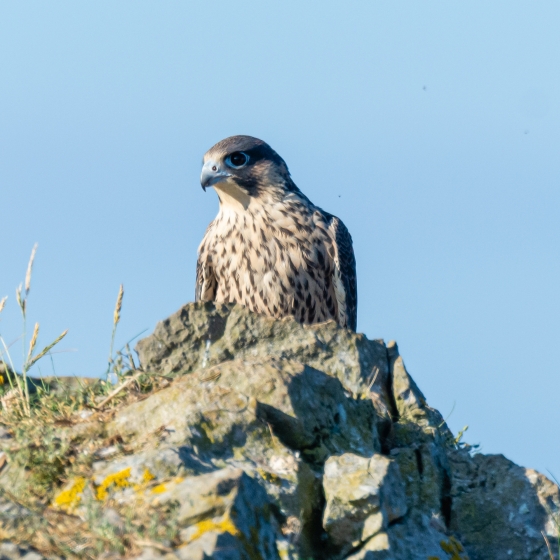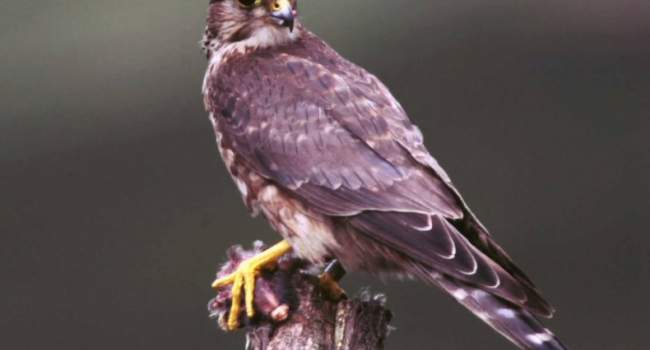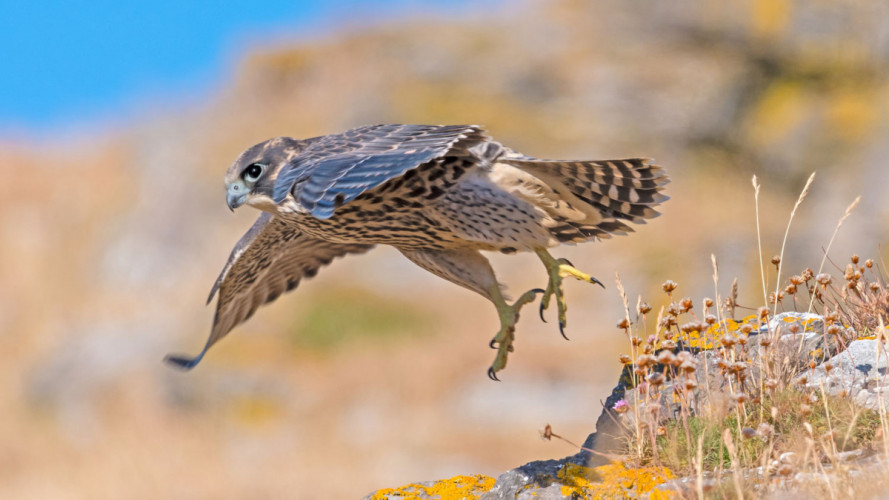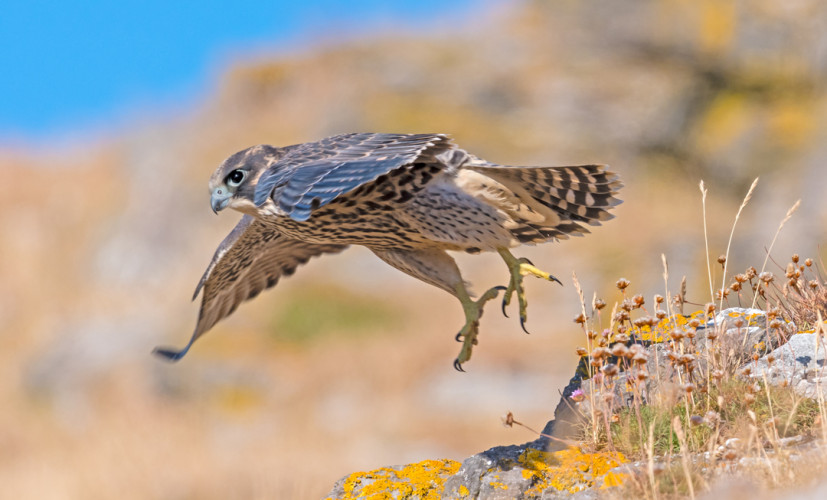Peregrine
Falco peregrinus (Tunstall, 1771)
PE
 PEREG
PEREG  3200
3200

Family: Falconiformes > Falconidae

The Peregrine has a muscular, chunky profile for a falcon, and an increase in numbers and range means that has become a more common sight for birdwatchers across Britain & Ireland.
Breeding Peregrines are well studied. Having recovered from the lows of the 1960s, the long-term population trend has been one of increase, although this does mask regional differences. Lowland birds have taken advantage of urban and industrial structures for nesting (from cooling towers to cathedrals) and plentiful urban prey.
Conversely, upland Peregrine have been in decline, in part thought to be linked to ongoing persecution.
Exploring the trends for Peregrine
Our Trends Explorer will also give you the latest insight into how the UK's Peregrine population is changing.
trends explorerIdentification
Peregrine identification is sometimes difficult. The following article may help when identifying Peregrine.
Identifying Kestrel and Merlin

This video looks at two often confused falcons, the Kestrel and Merlin, and discusses the key features for separating the two.
SONGS AND CALLS
Listen to example recordings of the main vocalisations of Peregrine, provided by xeno-canto contributors.
Other
Begging call
Alarm call
Call
Develop your bird ID skills with our training courses
Our interactive online courses are a great way to develop your bird identification skills, whether you're new to the hobby or a competent birder looking to hone your abilities.
Browse training coursesStatus and Trends
Population size and trends and patterns of distribution based on BTO surveys and atlases with data collected by BTO volunteers.
CONSERVATION STATUS
This species can be found on the following statutory and conservation listings and schedules.
POPULATION SIZE
| UK (breeding) | 1750 Pairs (2014) |
| BOU Category | A |
POPULATION CHANGE
The number of breeding pairs in the UK and Isle of Man is exceptionally well known. There is an estimate of 874 pairs for the 1930s and the population has been estimated every decade since 1961 as follows: 1961 - 385 pairs; 1971 - 489 pairs; 1981 - 728 pairs; and 1991 - 1,283 pairs (BTO/JNCC/RSPB/Raptor Study Groups; Ratcliffe 1993). In 2002, 1,437 breeding pairs were found in the UK and Isle of Man (Banks et al. 2003, 2010) though around 50 pairs were missed in Wales (Dixon et al. 2008). The latest figure, 1,769 pairs in 2014, represents a further increase of 22% overall since 2002 (Wilson et al. 2018).
| UK breeding population |
-43% decrease (1995–2022) 
|
Exploring the trends for Peregrine
Our Trends Explorer will also give you the latest insight into how the UK's Peregrine population is changing.
trends explorerDISTRIBUTION
Peregrines breed in upland and coastal areas with suitable cliffs, and across much of the lowlands, where pairs will utilise quarries and man-made structures from pylons and power stations to churches and cathedrals.
Occupied 10-km squares in UK
| No. occupied in breeding season | 1552 |
| % occupied in breeding season | 51 |
| No. occupied in winter | 2226 |
| % occupied in winter | 74 |
European Distribution Map
DISTRIBUTION CHANGE
Peregrine breeding range has tripled in size since 1968–72. Similarly, the winter range in Britain has doubled since the 1981–84 Winter Atlas, with gains primarily across lowland England. In Ireland a 51% winter range increase has seen expansion from the coast to the midlands.
Change in occupied 10-km squares in the UK
| % change in range in breeding season (1968–72 to 2008–11) | +186.1% |
| % change in range in winter (1981–84 to 2007–11) | +99.1% |
SEASONALITY
Peregrines are recorded throughout the year.

Movement
Information about movement and migration based on online bird portals (e.g. BirdTrack), Ringing schemes and tracking studies.
RINGING RECOVERIES
View a summary of recoveries in the Online Ringing Report.
Foreign locations of birds ringed or recovered in Britain & Ireland

Biology
Lifecycle and body size information about Peregrine, including statistics on nesting, eggs and lifespan based on BTO ringing and nest recording data.
PRODUCTIVITY & NESTING
Exploring the trends for Peregrine
Our Trends Explorer will also give you the latest insight into how the UK's Peregrine population is changing.
trends explorerSURVIVAL & LONGEVITY
View number ringed each year in the Online Ringing Report
Maximum Age from Ringing 
|
21 years 10 months 24 days (set in 2016) 
|
Typical Lifespan 
|
7 years with breeding typically at 2 year |
Adult Survival 
|
0.81±0.034  
|
Juvenile Survival 
|
0.6 (in first year) 
|
Exploring the trends for Peregrine
Our Trends Explorer will also give you the latest insight into how the UK's Peregrine population is changing.
trends explorerCODES & CLASSIFICATION
Ring size 
|
G |
Field Codes 
|
2-letter: PE | 5-letter code: PEREG | Euring: 3200 |
For information in another language (where available) click on a linked name
Research
Interpretation and scientific publications about Peregrine from BTO scientists.
CAUSES AND SOLUTIONS
Causes of change
The UK population size, distribution and breeding performance have all largely recovered from the poisonous effects of organochlorine pesticides in the 1950s and 1960s (Newton 2013). Illegal persecution continues to limit numbers in the uplands, and food supply may also be a limiting factor in some areas.
Further information on causes of change
Populations and breeding performance have declined, however, in northwest Scotland and the Northern Isles (Crick & Ratcliffe 1995). The overall increase between the 2002 and 2014 surveys masks a major distributional shift away from the uplands (North East Scotland Raptor Study Group 2015, Wilson et al. 2018) and towards lowland regions and the coast; Peregrine pairs in England have increased fivefold since 1981 and now, for the first time, outnumber those in Scotland (Wilson et al. 2018). Illegal persecution continues to limit numbers in the uplands, and food supply may also be a limiting factor in some areas; however persecution in lowland areas decreased during the 20th century, allowing numbers to benefit from the ban on organochlorine agrochemicals and from increased use of human structures as nest sites (Wilson et al. 2018).
Nest record information for the UK as a whole shows a significant rise in the number of fledglings per breeding attempt. This could at least partly reflect the distributional changes: urban Peregrines have a higher number of fledglings per breeding attempt than rural birds, possibly linked at least in part to higher prey availability (Kettel et al. 2018a, 2018b). In northern England, breeding productivity on grouse moors has been 50% lower than at nests in other habitats, indicating that illegal persecution on land managed for Red Grouse shooting remains an important pressure on the population (Amar et al. 2012).
Information about conservation actions
Although this species is increasing across many lowland areas of the UK, actions to reduce persecution are required to reverse recent declines in the uplands, where illegal persecution is believed to limit the population (see Causes of Change section).
Elsewhere, there are possible concerns about the risk of genetic introgression from escaped falcons following increases in the numbers of Peregrines and hybrid falcons in captivity (Fleming et al. 2011).
PUBLICATIONS (2)

Contrasting long‐term trends in age‐specific survival of Peregrine Falcons (Falco peregrinus) in Britain using smoothed estimates of recovery probabilities
Living fast: using ringing data to look at survival of British Peregrines

The breeding population of Peregrine Falcon Falco peregrinus in the United Kingdom, Isle of Man and Channel Islands in 2014
Breeding Peregrines on the up thanks to growth of lowland populations
The return of breeding Peregrines to former haunts, and the colonisation of urban sites such as industrial buildings and cathedrals, has not gone unnoticed by birdwatchers. It is only now, however, with the publication of the results from the latest national Peregrine survey, that we can put figures on the changing fortunes of this stunning bird of prey.
Links to more studies from ConservationEvidence.com
- Use of nest boxes by goldeneyes in eastern North America
- Comparison of survival rates of captive-reared and wild-bred Mauritius kestrels (Falco punctatus) in a re-introduced population
- Nestbox provisioning in a rural population of Eurasian kestrels: breeding performance, nest predation and parasitism
Read more studies about Peregrine on Conservation Evidence >
Would you like to search for another species?












Share this page